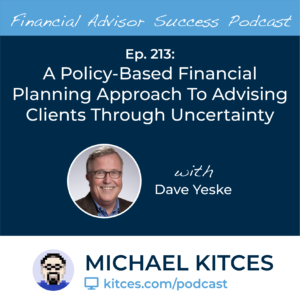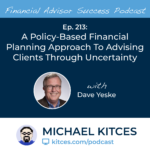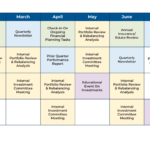 Welcome back to the 213th episode of the Financial Advisor Success Podcast!
Welcome back to the 213th episode of the Financial Advisor Success Podcast!
My guest on today's podcast is Dave Yeske. Dave is the co-founder of Yeske Buie, an independent RIA based in San Francisco that oversees 740 million of assets under management for more than 300 affluent clients. What's unique about Dave, though, is the way he has blended together academic financial planning research with the practice of financial planning, culminating in a policy-based financial planning approach that frames financial planning, not in terms of the recommendations he makes for specific client situations, but the policies he set with clients to help them confidently handle any number of future scenarios that might arise.
In this episode, we talk in-depth about how Dave applies his policy-based financial planning approach at Yeske Buie, the monthly reports they generate for retired clients to help them see whether they're in their safe spending policy guidelines, the quarterly tax reports they create to coordinate with their clients' outside accountants. The Money Quotient questionnaires they use on an annual basis to be certain that they're covering all the bases with their clients, and how using a policy-based approach to financial planning can help reduce client stress during turbulent markets.
We also talked about how Yeske Buie structures its own approach to financial planning with clients, why the firm has chosen to take a team-based approach for all clients it serves, the reason Yeske Buie chooses to charge a single consolidated assets under management fee despite the fact that in Dave's own words, 75% of what they do for clients is around the financial planning and not the investment management.
And why after hearing of the impending death of the AUM model for nearly his entire 30-year career, Dave now thinks it's more important to be nimble and adapt to changes in financial planning services and business models over time, rather than just trying to predict what the future may hold. And be certain to listen to the end, where Dave shares why he has such a passion for academic research despite being a self-admitted late bloomer in his own journey through college.
The reason that Dave got so involved in the Financial Planning Association and how volunteering back to the profession has advanced his own career, and how even financial planners who teach their clients about long-term compounding seem to under-appreciate the way that compounding works in our own advisory businesses, as Dave reflects on how painfully slow and difficult was for the first six years of his business, but how dramatically the growth began to accelerate in the years that followed and has continued ever since.
So whether you’re interested in learning more about why Dave pursued getting his doctorate while running his own firm, how he may have created the first-ever online client portal, or why he is trying to become 'dispensable' in his firm, then we hope you enjoy this episode of the Financial Advisor Success podcast.








 Welcome back to the 212th episode of the Financial Advisor Success Podcast!
Welcome back to the 212th episode of the Financial Advisor Success Podcast!

